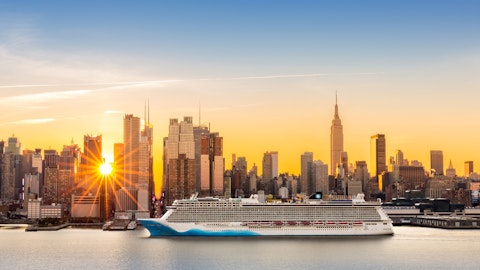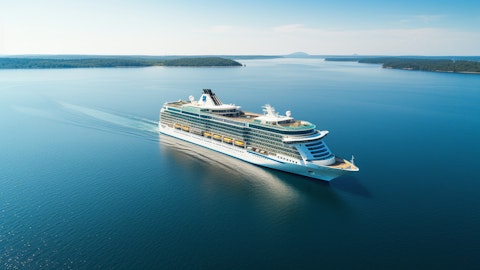Sven-Olof Lindblad: Yeah. It’s Sven here. I think it’s a combination of both. I mean, you know, somebody obviously got a hold of a spreadsheet at a certain point and said, wow this business looks like it has, tremendous potential. And because when you think about it, the explosion of entries in the last five years is just I’m impressed. It’s so, you know, so many more ships than were ever imagined in this segment. So it’s unprecedented. So I think to be totally honest, I think what people have probably done is underestimated the complexity of expedition travel. If you’re going to remote areas, you have to understand geography, have the right teams, or else you’re gonna get into trouble. You have to you have to have good deep relationships with the with the people in the institutions in those countries, etc., etc., etc.
So it’s actually quite complicated. The other thing is I think people maybe have underrated the intelligence of the audience in certain instances because the audience is very sophisticated, that that does this kind of thing. And, you know, they care deeply about quality. What is the quality of the staff? What is quality of the experience? How well thought out are the itineraries, etc., etc., etc. And then and then brand, of course, as I mentioned earlier, is I think an important thing. I mean, obviously, our brand is very, very well known to a very, very small number of people. I mean, because when we started expedition travel was not a it was not a big category. But for people that are that are that have any interest in that category, and that includes the trade are, you know, we are very well known in that regard.
But obviously, National Geographic is a brand that everybody on the planet knows. And so the combination of the two, create something I think quite meaningful or very, very meaningful that that, you know, helps those interested in expedition travel sort of migrate in our direction. I hope that answers your question.
Chris Woronka: Yeah. Yeah. No. Thanks, Sven. And just a follow-up, you know, On the cost side, and I totally understand and heard what you mentioned about the national geographic fees and the change there. But on the other things and maybe even look at it ex fuel, is there anything, you know, to suggest that you see moderation on the pressure coming in the second half? I know some of the costs can be kind of lumpy, insurance, things like that. I mean, is there any visibility into lower increases moving forward?
Craig Felenstein: Sure and thanks for the comments earlier, Chris. So there’s a couple of things in the cost that will, I would say, mitigate a bit. One is, as you can imagine, the first quarter of the year is a big quarter from us, from a cash receipt perspective, both from a deposits on future travel as well as, down payments for new reservations. The credit card fees are definitely higher in Q1. So the growth in Q1e there would be higher than it would be later in the year. The second thing is, there are some timing issues associated with some of the land company costs that come into the first quarter. You can see the flow through from a land company profitability perspective in the first quarter is not what it is later in the year.
So you should see, what I would say better margins I would say on the land business certainly in the rest of the year. So those are the big ones. There’s a little bit of currency hit in the first quarter related to some of the currency movements and some of the operations at our land companies as well. So that should abate itself as well. So those are some of what I would say is one offs that you’ll see, not flow through the rest of the year.
Sven-Olof Lindblad: So if I can just I add one thing, Sven here. It’s because, you know, Craig and I talked about this — talk about this a lot. Obviously, there is an expectation on the part of a lot of people for the occupancies to go up, rightfully so, and they will go up by the way. But more important than occupancy in the short term is price integrity in the long term. Because what what’s you know, one of the things that you really sort of analyze a business like this, let’s say you all you can get to we could get to a 100% occupancy tomorrow if we took on some really bad habits, that would have a very negative effect on the business long term. So ships, small ships, expedition ships cannot function at revenues that are 50%.
It’s not possible — it’s not sustainable. And so we our emphasis is let’s do let let’s drive up occupancy, but at the same time, let’s make sure we do not violate price integrity. Because once you do too much of that, it’s hard to come back. Right? So I just want to clarify that point.
Chris Woronka: Excellent. Thanks, guys.
Operator: Thank you. The next question is from Alex Fuhrman with Craig-Hallum Capital. Your line is open.
Alex Fuhrman: Hey, guys. Thanks for taking my question. And, Craig, sorry to hear that you’re gonna be leaving the company. Sven, you mentioned that some of your geographies, I think Antarctica, in particular, you’re seeing a lot more competitive pricing from some of your competitors with the two for one deal. Curious, do you think a lot of this is ultimately short term in nature? Or do you think given the nature of your small ships and how nimble you can be, are there maybe opportunities to reposition some of your ships for part of the season to even more remote, less visited destinations where you’d have more pricing power over time?




